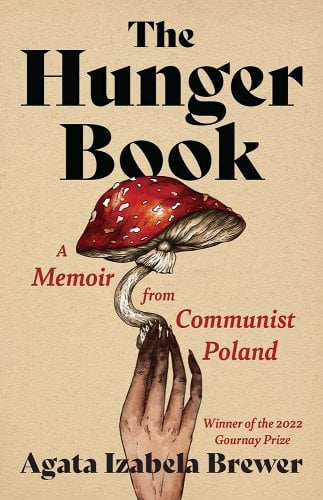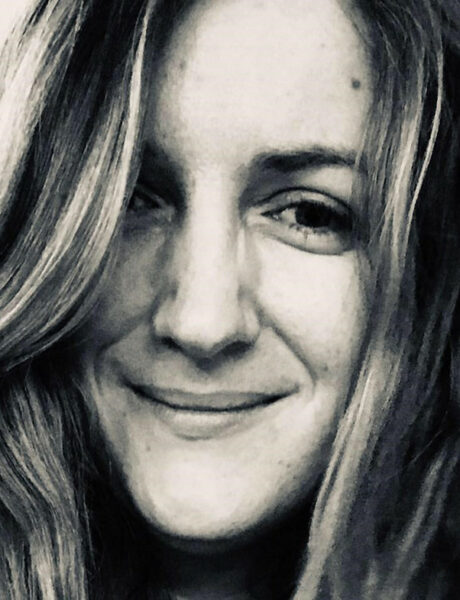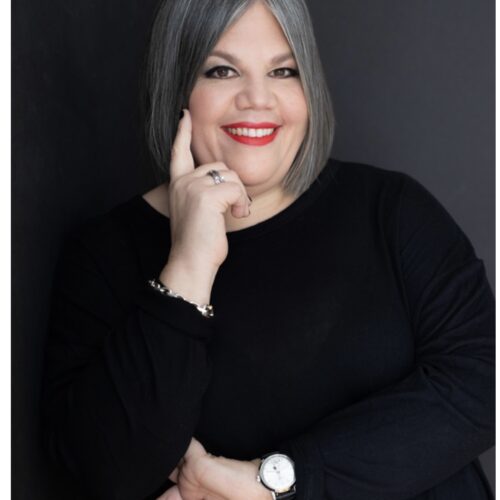Interview by Amy Fish
 In The Hunger Book, Agata Izabela Brewer evokes her Polish childhood under Communism, where the warmth of her grandparents’ love and the scent of mushrooms drying in a tiny apartment are as potent as the deprivations and traumas of life with a terrifyingly unstable, alcoholic single mother. Brewer indelibly renders stories of foraging for food, homemade potato vodka (one of the Eastern Bloc’s more viable currencies), blood sausage, sparrows plucked and fried with linseed oil, and the respite of a country garden plot, all amid Stalinist-era apartment buildings, food shortages, martial law, and nuclear disaster in nearby Ukraine.
In The Hunger Book, Agata Izabela Brewer evokes her Polish childhood under Communism, where the warmth of her grandparents’ love and the scent of mushrooms drying in a tiny apartment are as potent as the deprivations and traumas of life with a terrifyingly unstable, alcoholic single mother. Brewer indelibly renders stories of foraging for food, homemade potato vodka (one of the Eastern Bloc’s more viable currencies), blood sausage, sparrows plucked and fried with linseed oil, and the respite of a country garden plot, all amid Stalinist-era apartment buildings, food shortages, martial law, and nuclear disaster in nearby Ukraine.
Brewer reflects on all of this from her immigrant’s vantage point, as she wryly tries to convince her children to enjoy the mushrooms she gathers from a roadside and grieves when they choose to go by Americanized versions of their Polish names. Hunting mushrooms, like her childhood, carried both reward and mortal peril.
The Hunger Book, which includes recipes, is an unforgettable meditation on motherhood and addiction, resilience and love.
Amy Fish: Are you teaching any courses this semester? If so, which ones?
Agata Izabela Brewer: I teach writing and literature courses. This semester I’m teaching Freshman Composition, Introduction to the Study of Literature, and Postcolonial Literature and Theory. Next semester I will be leading an advanced Creative Nonfiction workshop, and I’ll also teach Science Fiction as well as a class on Literature and War, which will end with a 7-day trip to Poland—free for our students!
It’s a wide array of courses, with lots of prep, which means not much time during the day to write, but I also find interactions with students and with the books I assign inspiring, sometimes in unexpected ways. Expanding my reading horizons to a variety of genres and authors sometimes prompts me to write in new ways or explore subjects from unusual perspectives. Squeezing in writing time, however, is another matter. Between home, work, and community engagement, I have little wriggle room. So I put down writing blocks on my schedule, just like classes and appointments. Zooming with writer friends helps, too, because we hold each other accountable.
AF: The readers of Hippocampus Magazine are writers too, and we’re always interested in your journey. Can you please tell us how this book came to be? How did you get from “I have an idea for a memoir” to holding The Hunger Book in your hands?
AIB: Initially, I had an idea for a memoir essay, not a full-length book. I was still completing a scholarly manuscript, so I didn’t want to get distracted with another long-term project. But I did get distracted. The more I wrote about my Polish childhood and my new life in the U.S., the less interested I was in that first project that started feeling a little too esoteric to me. I added one personal essay to another and then to another, and after a couple of years, I thought that maybe I had a book in me. That first essay ended up being a part of the final chapter of my memoir.
For a while, I wasn’t sure whether what I was writing resonated with any readers out there. I had lots of doubt, lots of annoying little voices in my head saying that nobody needed yet another story about childhood trauma, an unhinged alcoholic parent. The word “resilience” already echoed through all kinds of writing, from scholarly to creative, and I wasn’t interested in writing yet another resilience story. But I guess I did write a resilience story, sort of, one that doesn’t necessarily have a clear-cut happy ending. It was when one of those essays, “Birds,” won the Black Warrior Review Creative Nonfiction Prize that I realized readers may actually care about these topics and appreciate my writing about them. That award gave me an impetus to finish the project and look for an agent. I had to take frequent breaks from writing, though, when I started experiencing panic attacks as I recalled some of the sensory details from difficult moments in my life. Finishing the book wasn’t easy for that reason.
Getting it published also wasn’t easy. I sent out agent queries, and time and again people would tell me that my story was compelling and beautifully written but not marketable. Then one day, I got an email from the Ohio State University Press that my manuscript won their Gournay Prize, and my memoir-in-essays will be published by Mad Creek Books. That’s how I eventually got to hold the book in my hands.

Agata Izabela Brewer
AF: You write about Polish culture with respect and clarity, in part using food to illustrate the difference between the way you grew up and the way you live now. Tell me about your decision to include recipes in the book. Did your editor share your vision? How did you choose which recipes to include? If I’m only going to cook one thing, which would you recommend?
AIB: My editors were supportive of my vision, which did not necessarily align with mainstream publishers looking for a less experimental narrative. In fact, after a back-and-forth with one agent, I realized that if I were to shoot for a major commercial publisher, my memoir would have to take a completely different shape, one I wasn’t interested in. So I went back to my many drafts and tried to locate the moment in which I strayed away from my initial vision, which I should have trusted from the very beginning. That vision included recipes because food is such a key thread in the book.
I don’t know which recipe I would recommend over others… Are you adventurous? Make bigos. Vegetarian? Try kopytka. Do you eat with relish the inner organs of beasts and fowls? Chicken liver. Did you catch a cold? Try żurek, with lots of horseradish. Now you made me hungry!
AF: The stories about your mother and her addiction must have been difficult to tell. How did you look after yourself while you were writing? Do you have any strategies you would like to pass on for writers who need to revisit difficult times when writing their memoirs?
AIB: Be kind to yourself. Give yourself lots of grace. And don’t rush. If you can afford it, work with a good therapist. If not, rally your support network to be there when you need another human to take care of you for a moment. The number one thing for me was to pace myself. When I tried to rush through a draft of a chapter, and I had to recall a lot of sensory details about traumatic moments in my childhood—say, my mom’s smell after she tried to commit suicide, the color of the curtains behind her, my brother’s hand in my hand—I would later pay for this near-total reimmersion in trauma. My therapist reminded me to take breaks, sometimes even for weeks at a time, when I reacted with debilitating panic attacks.
I had thought that writing my story would be cathartic. You know, I heard these comparisons of writing to bloodletting, and they sounded clichéd, so I dismissed them. But there is some truth in them. Writing itself is hard. Add a difficult topic, and the process is even more forbidding. So find your healing place or people and go there often. For me, snuggling with my kids and dog was healing. Gardening was healing, too: getting my hands dirty, feeling the soil and manure between my fingers, hauling compost in a yard cart, smelling ripe tomatoes or strawberries. So do you own healing thing after each writing session, even for a moment. Walk your dog. Cook your favorite meal. Get on a bike. Call a friend.
AF: Did nursing the rat back to health with your mom make you more or less likely to have a pet or to let your kids have pets? Please tell me about any pets you have now (type, names, ages).
AIB: Well, my mother was the one who nursed that pustule-covered rat back to health. I was kinda disgusted with the rat until her fur was nice and shiny again. My mother, though not confident or warm around kids, was wonderful with animals. Dogs, cats, hamsters, fish—she took care of them with the kind of love and devotion I envied because I didn’t experience that from her too often.
I do have a dog now, a chihuahua-terrier mix called Pixie. She is such a loving and patient dog! Whenever anyone at home cries, she jumps on our lap and licks our tears away. She’s protective of my kids, and she has endured all kinds of shenanigans from them with stoicism not known among chihuahuas.
On occasion, we’ll get a short-term pet from our garden—a crawdad we named Philabob, two ladybugs (Sam and Fred), a praying mantis, a grasshopper, all kinds of caterpillars, whatever my kids or husband bring home. It’s great fun seeing animals and insects with my kids’ eyes, giving them imagined stories and names.
AF: How would you describe the structure of this book?
AIB: The memoir is divided into 10 chapters, or essays, each (except the last one called “Hunger”) named after a food item, and all linked by the dominant metaphor of hunger—for food, for love, for recognition, for safety. Another metaphor that reappears throughout the book is that of mushrooms. Throughout the book, I also tell stories about my grandparents who were my de facto caregivers, my primary nourishment and sustenance, though they themselves suffered through hunger during World War II and Communism. Briefly reaching back to my grandparents’ war traumas allows me to ponder the importance of epigenetics in trauma and healing.
The book’s narrative, though propelled by the major story about my mother’s addiction and my yearning for affection, is somewhat fragmentary, as are the workings of a brain learning to create meaning from traumatic events. I tried to give coherence to the narrative through dominant themes of literal and metaphorical hunger as well as the dominant trope of mushrooms.
AF: Was there anything that you were hoping to include but that didn’t make it into the final book?
AIB: Yes, there’s lots of material that didn’t make it to the book. As most writers, I revised partly by cutting the excess, by trimming the irrelevant and tangential prose. I always save my deleted pages, paragraphs, and sentences in a separate folder because these bits and pieces often evolve later into something new and exciting. I try not to be too precious about my sentences. If an editor or a friend tells me something should be cut, 9 out 10 times, I will do it, even if I’m attached to an image or turn of phrase. It helps to remember that it’s not permanently gone, only shifted to a potentially new context, banished until I have time to return to it and shape it anew.
AF: I love your cover, especially understanding the call to that particular mushroom. Can you tell us about how the design was chosen and how much (if any) input you had?
AIB: I love it, too! It was designed by Melissa Dias-Mandoly, and, like you said, it echoes the dominant thread in the book. A poisonous mushroom whose roots, or mycelia, look like a ghoulish hand grabbing it from beyond the grave. It encapsulates the book’s gothic themes perfectly, and yet it also has this vibrant red mushroom cap that hints at both the bloody history of 20th-century Poland and the colors on our dinner tables—the beets and radishes, the strawberries and red currants, the occasional chunk of meat, the blood sausage, the fish pulled out of a bathtub and butchered in a kitchen sink.
Early in the publishing process, I was asked for cover ideas, and I suggested, among other things, a fly agaric mushroom, since it appears through the book. I also suggested there could be a drawing of mycelia—the root network in the soil nourishing not just the mushrooms, which are the fruiting bodies of this network, but also nearby trees and other plants. When the press came back with this image, I hesitated for a moment. I love its raw power, but I also worried that maybe I portrayed my mother in this ghoulish light because I thought the hand reaching upwards represented my mother’s reach. But the more I looked at the proposed cover, the more I liked it. And now I think it was a great choice.
AF: We are always looking for book recommendations. Have you read anything good this year that you would like to suggest to our readers?
AIB: I just re-read two books by Brian Turner: his poems from Here, Bullet and his memoir, My Life As a Foreign Country. Between the wars in Ukraine and in Gaza (and elsewhere, of course), I’ve been thinking about political violence, complicity, empathy, and the many ways of witnessing injustice. So I assigned Turner’s writing to my students, in addition to other books, and I re-read them in the current context of new wars but old ethical dilemmas. I also returned recently to Octavia Butler and N.K. Jemisin, whose fiction deals with violence and natural disasters.
Among newer publications, I read David Diop’s Beyond the Door of No Return, translated by Sam Taylor and published this fall. I loved Diop’s At Night All Blood Is Black, about a Senegalese soldier fighting in World War I, so I couldn’t wait for this new novel about a French botanist in Senegal. It didn’t disappoint, though its epistolary form is starkly different from the unreliable and sometimes unhinged narration in At Night All Blood Is Black. I’m a sucker for beautifully wild, unusual prose.
Agata Izabela Brewer was born and raised in Poland. A teacher, a mother, an activist for immigrant rights, and a Court Appointed Special Advocate, she is Professor of English at Wabash College. Her creative writing has appeared in Guernica and Entropy. The Hunger Book is her first book of creative nonfiction.

Amy Fish
Staff Reviewer & InterviewerAmy Fish is a writer of true stories, some of which are funny. She is the author of “I Wanted Fries with That: How to Ask for What You Want and Get What You Need” (NWL 2019) and “The ART of Complaining Effectively” (Avmor 2015). Amy is currently doing her MFA at Kings’ College in Halifax, Canada. She is the Ombudsperson at Concordia University in Montreal, where she lives with her husband and kids.


